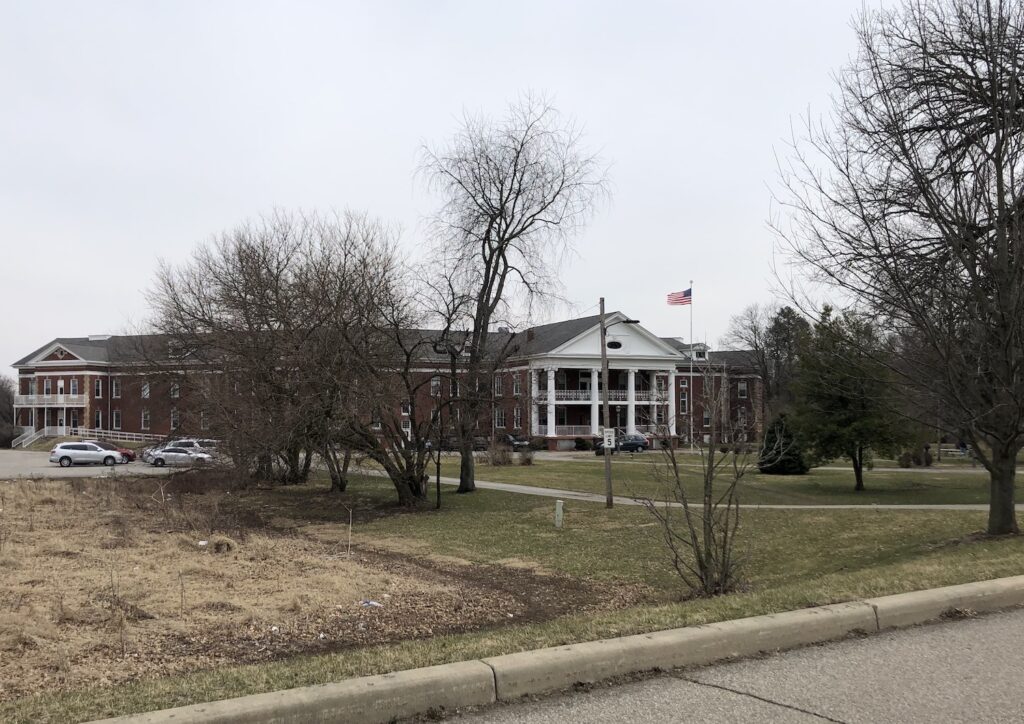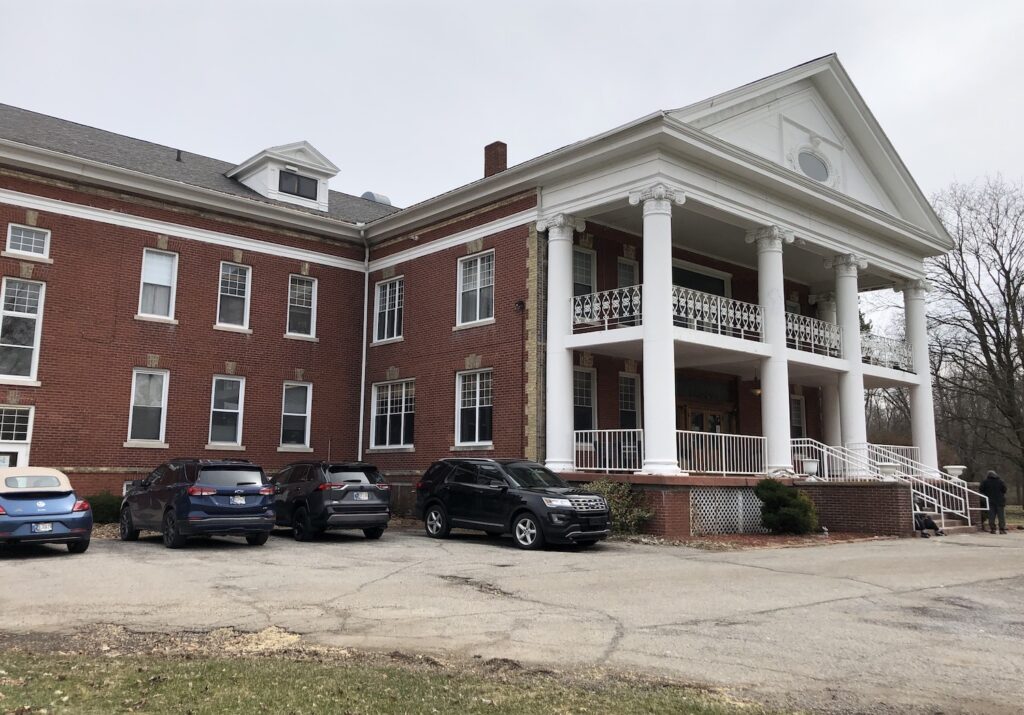Oh no. Not another one! I have written before about National Register buildings I have lovingly researched and gotten listed, only to see them threatened and even demolished years later. A listing will not save a historic structure, and we must remain vigilant!

Now it is Portage Manor on the northwest side of South Bend, the St. Joseph County Infirmary (its original name). County homes in general are a particularly endangered species. Once upon a time, every one of our 92 counties had one. At the time I wrote the nomination 20-odd years ago, there were about thirty still in existence and in use; today there are fewer than ten! The county commissioners almost certainly have been planning this move for a good while. Surely it is obvious to anyone that they want to sell off the land for development, since sprawl has been galloping up Portage Avenue at a furious pace in the last twenty years, and that beautiful rolling farmland on which Portage Manor sits would be oh-so-much better with yet another subdivision or big box store surrounded by pavement. The commissioners did not renew the lease on the farmland that had given the home at least some stable income. Needed maintenance has been held off with temporary fixes, an old trick well known to those of us in preservation. But Portage Manor is a handsome building that houses a community of people living out their lives with dignity and compassion. It should not be closed; it must not be destroyed.

In 1905 South Bend architects Freyermuth and Maurer prepared plans for a new county infirmary that would replace a smaller, earlier facility in a different location. The St. Joseph County Infirmary built the following year was the last of a series of care facilities established by the county for the elderly and incapacitated indigent. By the turn of the twentieth century the St. Joseph County Asylum, or poor farm, as it was commonly known, had long since ceased to serve the needs of its residents. Inspectors from the State Board of Charities sharply criticized the facility and its “antiquated and inadequate buildings.”
The mission of these county institutions in general had begun to change in the 1890s, and while far from enlightened by today’s standards, poor farms and asylums (essentially interchangeable terms) were attempting to become something other than dumping places for society’s unwanted. The degree to which they succeeded over the next several decades is questionable; admission records from the mid-nineteenth century through the first few decades of the twentieth do not suggest a great deal of change as to whom the institution accepted. Initially poor farms provided minimal refuge for an astonishing variety of indigents, including those who were elderly, chronically ill, convalescent, mentally ill, disabled, injured, unwed mothers, or simply homeless. Ages ranged from infants (when in the company of a needy parent; orphans went elsewhere) to people in their nineties. Those who could usually were expected to work, and there was little if any effort to distinguish among them to meet their needs. The common denominator was poverty. As other public institutions geared toward specific needs were established by local and state governments, some inmates were sent to these other types of facilities, or else went there initially. In the early twentieth century, for example, many epileptics were sent to the state’s new Epileptic Village near New Castle. Nevertheless, many who might have been better served elsewhere still ended up in the county asylum, especially those diagnosed as insane. State facilities were too crowded to accommodate them all.
In 1905 the St. Joseph County Board of Commissioners bought the Rezeau Brown farm northwest of South Bend, just past the Riverview Cemetery on Portage Avenue. The property included several farm buildings, a wooded area, and land that was largely level and proven quite suitable for general farming. Little time, then, need be wasted in establishing the new poor farm’s self-sufficiency. Over the next few decades old buildings were remodeled and additional farm structures were erected, such as a hay barn, a large hogshed, and a small building for butchering.

The St. Joseph County Infirmary–its name reflecting the Progressive-Era changes in the theory, if not the fact, of the facility’s mission–opened with great fanfare as “a model poor farm” in February 1907. The new asylum was to house “those who [were] so unfortunate as to be left alone in the world without money and without friends or who are afflicted with the ravages of disease and who are unable to procure the necessary hospital service without money.” Records indicate that indeed, among others, anyone from abandoned pregnant women to severely injured laborers to those of any age who were “feeble-minded,” found temporary or permanent refuge within the county infirmary.
Certainly the new facility was vastly superior to the previous poor asylum, but life at the St. Joseph County Infirmary was no bed of roses. Anyone who was capable was required to work (although the records imply this was not always the case), rules were extremely strict, and occasionally residents were “dismissed for disobedience.” A few even ran away; many more may have wished to if they could. Men and women were segregated; those diagnosed “insane” were locked in metal cages in the area termed the “insane ward” near the boilerhouse, part of the original accommodations offered at this new “model” facility. Conditions grew so crowded in the 1930s that beds were crowded nearly head to foot in the cells to house inmates who were often, at worst, merely “feeble-minded.” In the 1950s patients diagnosed with severe mental illness were transferred to the new Beaty Memorial Hospital in Westville. The cells, however, remained in use through the 1970s for inmates who tended to wander and sometimes for residents who broke the still-rigid rules. (For example, talking was not allowed during meals.)
In 1947, by act of the Indiana General Assembly, the name of the facility became the St. Joseph County Home, again reflecting changes in care and management philosophy. The average population of county infirmaries had grown older and less able-bodied; this, along with the fact that mechanized farming was rapidly replacing earlier, more labor-intensive practices, suggested that “productive employment of residents is futile” and should be performed only on a voluntary basis. As early as the mid-1930s the idea of discontinuing farming at the county infirmary was considered, but still it remained in place for several more decades, until the late 1980s. Thereafter, the land was leased to a local farmer.
The new idea of the county home was to be just what the name implied: “a congenial place of abode,” a safe haven. Once again, the mission remained more theory than fact for some decades, although conditions overall had improved greatly since shortly after the turn of the century when the facility first opened. By the early 1970s the name had changed yet again, to Portage Manor. In the late 1980s Portage Manor became a state-licensed health care center and underwent a major renovation that preserved much of the building’s historic character while creating a cheery, home-like interior–the mission fulfilled at last!

I visited Portage Manor this week. I was not allowed past the lobby but it still appeared cheerful and welcoming to its residents, many of whom were outside sitting amidst the lovely wooded grounds enjoying the early spring day, grey but with soft breezes. This is their home, not just a bland and boxy institution. Portage Manor is among the best of Indiana’s surviving county homes and retains a high degree of integrity. It stands as a three-dimensional document of the history of social welfare in St. Joseph County. More than that, it is in fact a true home to a community of people who need it–and each other–and it reminds us of the better angels of our nature, which is something the county commissioners seem to have forgotten.

Very informative!!!